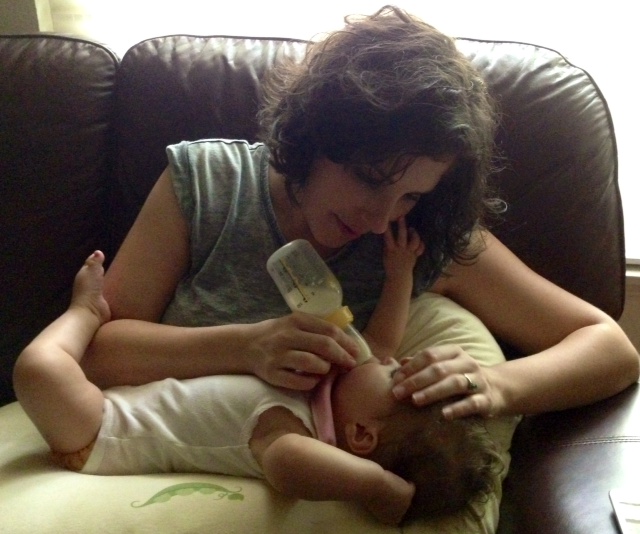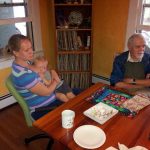By Jaymie Roberts
When I was a little girl, I would “breastfeed” my Cabbage Patch Preemie. I would lift my shirt and put the hard plastic face to my flat chest. To me, this was how you fed a baby. Twenty years later, I was pregnant and instead of playing house I was growing a baby—a real one, not the plastic kind.
I read the books. I bought nursing tops and a huge stack of organic cotton nursing pads. I bought an expensive nursing brassiere that very closely resembled Mrs. Doubtfire’s. I stocked the kitchen with fennel tea, Guinness stout, frozen cabbage leaves, and coconut water to ensure my milk arrived. I did everything I could think of to prepare for breastfeeding. I just forgot to prepare for the possibility that I couldn’t.
I would soon find that the make-believe breastfeeding of my youth more closely resembled reality than I ever could have imagined. A flat chest was traded in for milk-filled breasts, but a plastic doll was replaced by plastic flanges. You see, I couldn’t breastfeed my baby.
Camille was born after a twenty-five hour planned homebirth. It was exhilarating to know that my body had grown her and that I had the intervention-free birth that I wanted. As a result, I had the most amazing baby lying wide-eyed on my now empty belly. I could not wait to put her to my breast and feel her nurse, but that moment would never come. Camille would never latch.
To feed her, we made a makeshift supplementary nursing system (SNS) out of a nipple shield, catheter, and syringe. Every two hours, I would use the hand pump to draw my nipple out, put on the nipple shield and put the tip of the catheter in, attach the other end to the syringe, and put her on the breast. My fiancé would stand over us, slowly pushing expressed breast milk through the SNS. By the time one feeding was done and I pumped, it was time to do it all over again.
We received a tidal wave of bad news in her first two weeks of life, proving that her life outside of the womb would be anything but intervention-free. Camille was diagnosed with Pierre Robin Sequence (PRS), characterized by a cleft in her soft palate, micrognathia (a small lower jaw), and glossoptosis (a tongue that falls back into the cleft, causing an airway obstruction). At ten days old, she had her first echocardiogram, which showed two congenital heart defects—an atrial septal defect (ASD) and a ventricular septal defect (VSD). The holes were quite large and would require open-heart surgery. At eleven days old, her craniofacial team informed us that she would need surgery to repair the cleft and received special needs bottles to use for her feedings. We were devastated.
My baby’s birth defects made weight gain a struggle and I felt like I was constantly defending my baby and her size. I became obsessed with her weight gain, weighing her daily—sometimes twice a day. I recorded all of her feedings so that I knew exactly how many milliliters she was getting. Our cardiologist wanted her to be as big and strong as possible for surgery, without doing permanent damage to her heart. So much blood, sweat, and tears went into every gram gained. In my mind, if I could get her to gain weight, I could keep the surgery at bay, like it wasn’t reality.
I couldn’t feed her at the breast, but I was determined to feed her from the breast. My life revolved around the pump. Feed her, pump, feed her, pump, and then feed her again. I exclusively pumped for three months before I found out it was a thing and that other moms did it. I exclusively pumped for two weeks without a pumping bra (I didn’t know they existed), holding the flanges to my breasts for the entire length of the pump. During those first three months, I pumped an extra 1,000 ounces that I had to dump down the drain because of too much lipase. I pumped for months with raw, chaffed nipples before I figured out I should lubricate them with coconut oil. I had no idea what I was doing.
Throughout this terrifying journey, I would constantly hear things like, “You’re so strong” and “I don’t know how you do it.” The truth is, I’m not that strong. You get through it because you have no other choice. I took it day by day, busying my mind with what I could control. How much did I pump today? How much did she weigh this morning? This afternoon? How much did she eat? How much did I eat?
I hate that pump. So much of my family’s life is wrapped up in pumping, like the tubing is tangled around us and we’ll never break free. But I also love that pump. That pump is what made feeding my daughter possible. That pump saved me from the darkest moments of my life. That pump is what got me through handing my baby over to a nurse and saying goodbye for seven hours while she had open-heart surgery. That pump is what got me through seeing her whimper in physical pain for hours, and then emotional pain for weeks. That pump is what got me through having to perform a delicate and intricate dance with wires and tubes every time I wanted to hold my baby or she wanted me to hold her. That pump is what got me through the seven days I lived in the pediatric ICU—the worst seven days of my life—where I continued to pump around the clock for her. And that pump is what will get me through her next surgery.
Breastfeeding may look different than I had planned, but I am giving my daughter Mommy’s milk the only way I can. Each time I finish a pumping session, remove the tubing, take the bottles off the flanges, unzip my pumping bra, and remove the flanges from my sore nipples, Camille giggles with excitement. She knows exactly where her milk comes from and that makes it all worth it.













